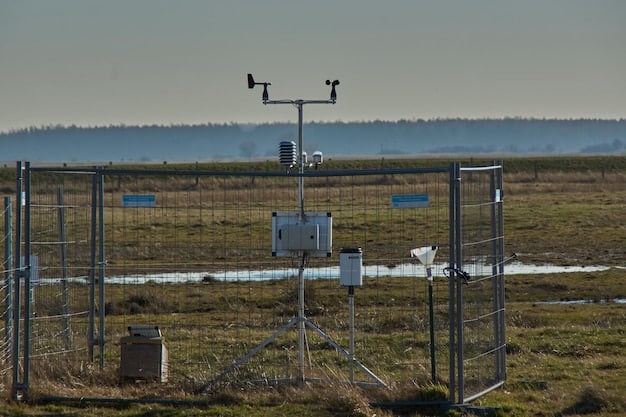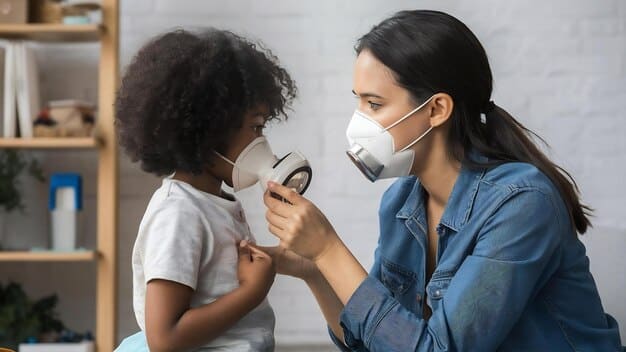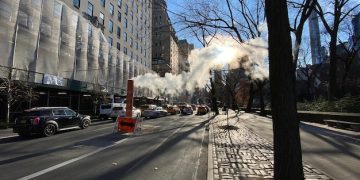Air Pollution & Respiratory Health: EPA Report Insights for US Residents

This article examines the impact of air pollution on respiratory health in the US, drawing insights from the latest EPA report, and highlights key findings, vulnerable populations, and mitigation strategies.
The impact of air pollution on respiratory health is a growing concern, particularly in the United States. The latest EPA report provides critical data and insights that can help us understand the severity of this issue and take informed actions.
Understanding Air Pollution and Its Sources
Air pollution is a complex mixture of particulate matter, gases, and other harmful substances that contaminate the air we breathe. Understanding the sources of these pollutants is crucial for developing effective strategies to mitigate their impact.
Major Sources of Air Pollution
Identifying the origins of air pollutants is the first step in addressing the problem. Various sources contribute to air pollution, each with its unique characteristics and impacts.
- Industrial Emissions: Factories and manufacturing plants release pollutants such as sulfur dioxide, nitrogen oxides, and particulate matter.
- Vehicle Exhaust: Cars, trucks, and buses emit carbon monoxide, nitrogen oxides, and volatile organic compounds.
- Power Plants: Coal-fired and gas-fired power plants release sulfur dioxide, nitrogen oxides, and particulate matter.
- Agricultural Activities: Farms can generate dust, ammonia, and pesticides that contribute to air pollution.
These sources vary in intensity and composition depending on the region and specific activities. By understanding these variations, policymakers and individuals can better target efforts to reduce pollution.
The Role of the EPA
The Environmental Protection Agency (EPA) plays a crucial role in monitoring and regulating air quality in the United States. The EPA sets standards for common air pollutants and enforces regulations to reduce emissions from various sources.
The EPA’s efforts include:
- Setting National Ambient Air Quality Standards (NAAQS): These standards define acceptable levels of pollutants to protect public health and welfare.
- Monitoring Air Quality: The EPA operates a network of monitoring stations to track pollutant levels across the country.
- Enforcing Regulations: The EPA enforces regulations on industries and other sources to reduce emissions.
- Research and Development: The EPA conducts research to better understand the sources, impacts, and control of air pollution.

The EPA’s data and reports provide valuable insights into the state of air quality in the United States, helping to inform policy decisions and public health initiatives.
Understanding the sources of air pollution and the role of the EPA is foundational to appreciating the significance of the agency’s latest report. This knowledge enables a more informed discussion about the health impacts and potential solutions.
Key Findings from the Latest EPA Report
The latest EPA report offers a comprehensive assessment of air quality trends and their implications for public health. Several key findings underscore the ongoing challenges and areas of progress in reducing air pollution.
Overview of Air Quality Trends
Recent data from the EPA indicates both improvements and persistent issues in air quality across the United States. While certain pollutants have seen significant reductions, others remain a concern in specific regions.
- Particulate Matter (PM2.5 and PM10): Levels have generally decreased over the past decades due to regulations on industrial emissions and vehicle exhaust.
- Ozone: Ground-level ozone continues to be a problem in urban areas, particularly during the summer months.
- Nitrogen Dioxide and Sulfur Dioxide: Emissions from power plants and industrial facilities have declined, but localized concentrations persist in some areas.
- EPA’s latest report highlights that while overall progress has been made, certain regions still struggle to meet national air quality standards. This disparity underscores the need for tailored strategies to address local pollution sources.
Specific Pollutants of Concern
The EPA report identifies specific pollutants that pose the greatest risk to public health. Understanding these pollutants and their sources is essential for targeted interventions.
The following pollutants are of particular concern:
- Fine Particulate Matter (PM2.5): Tiny particles that can penetrate deep into the lungs, causing respiratory and cardiovascular problems.
- Ground-Level Ozone (O3): A gas formed when pollutants from vehicles and industry react in sunlight, leading to respiratory irritation and damage.
- Nitrogen Dioxide (NO2): A gas emitted from combustion sources that can cause respiratory issues and contribute to the formation of ozone and particulate matter.
These pollutants have been linked to a range of health problems, particularly in vulnerable populations such as children, the elderly, and individuals with pre-existing respiratory conditions.
Geographic Disparities in Air Quality
The EPA report reveals significant geographic disparities in air quality across the United States. Certain regions, often those with high population density or industrial activity, experience disproportionately high levels of pollution.
Areas with poorer air quality include:
- Urban Centers: Cities with heavy traffic and industrial activity often have higher levels of ozone and particulate matter.
- Industrial Corridors: Regions with a high concentration of factories and manufacturing plants experience elevated levels of pollutants.
- Rural Areas: Agricultural activities and long-range transport of pollutants can impact air quality in rural communities.
Addressing these geographic disparities requires targeted strategies that take into account local sources and conditions. The EPA report provides valuable data and analysis to inform these efforts.
The EPA’s latest findings underscore the need for ongoing monitoring, regulation, and mitigation efforts to protect public health. By understanding the trends, specific pollutants of concern, and geographic disparities, stakeholders can work together to improve air quality for all Americans.
The Impact on Respiratory Health
Air pollution has a profound and widespread impact on respiratory health. Exposure to pollutants can trigger or exacerbate a range of respiratory conditions, affecting individuals of all ages and backgrounds.
Common Respiratory Conditions Affected by Air Pollution
Exposure to air pollutants can worsen several common respiratory conditions. Understanding how these pollutants affect the respiratory system is essential for protecting vulnerable populations.
Air pollution can exacerbate the following conditions:
- Asthma: Pollutants such as ozone and particulate matter can trigger asthma attacks and increase the severity of symptoms.
- Chronic Obstructive Pulmonary Disease (COPD): Long-term exposure to pollutants can contribute to the development and progression of COPD.
- Bronchitis: Air pollution can irritate the airways, leading to inflammation and bronchitis.
- Respiratory Infections: Exposure to pollutants can weaken the immune system, making individuals more susceptible to respiratory infections such as pneumonia and the flu.
Vulnerable Populations
Certain populations are more vulnerable to the respiratory health impacts of air pollution. These groups require special attention in efforts to protect public health.
Vulnerable populations include:
- Children: Children’s lungs are still developing, making them more susceptible to the harmful effects of air pollution.
- The Elderly: Older adults are more likely to have pre-existing respiratory conditions and weakened immune systems.
- Individuals with Pre-existing Respiratory Conditions: People with asthma, COPD, and other respiratory ailments are more sensitive to air pollutants.
- Low-Income Communities: Often live near industrial areas or busy roadways, exposing them to higher levels of pollution.

Protecting these vulnerable populations requires targeted interventions and policies that address the specific sources of pollution in their communities.
Long-Term Effects of Air Pollution on Respiratory Health
Long-term exposure to air pollution can have lasting effects on respiratory health. Chronic exposure can lead to the development of chronic respiratory diseases and increase the risk of premature death.
The long-term effects include:
- Increased Risk of Lung Cancer: Exposure to certain pollutants, such as particulate matter and benzene, has been linked to an increased risk of lung cancer.
- Reduced Lung Function: Long-term exposure to air pollution can impair lung function and reduce overall respiratory capacity.
- Increased Mortality: Studies have shown that long-term exposure to air pollution is associated with increased mortality from respiratory and cardiovascular diseases.
A comprehensive understanding of the impact of air pollution on respiratory health is crucial for developing effective prevention and treatment strategies. By addressing the sources of pollution and protecting vulnerable populations, we can reduce the burden of respiratory diseases and improve public health.
Air pollution significantly impacts respiratory health, exacerbating common conditions and causing severe long-term effects. Recognizing these impacts and safeguarding vulnerable populations is paramount for improving overall public health.
EPA Regulations and Their Effectiveness
The EPA has implemented numerous regulations to improve air quality and reduce pollution. Understanding these regulations and assessing their effectiveness is essential for continued progress.
Overview of Key EPA Regulations
The EPA’s regulatory framework includes several key regulations aimed at reducing air pollution from various sources. These regulations set emission standards, require permits, and promote the use of cleaner technologies.
The following environmental protection agency regulations are vital:
- Clean Air Act: Establishes national ambient air quality standards and regulates emissions from stationary and mobile sources.
- New Source Review (NSR): Requires new or modified industrial facilities to obtain permits and use the best available control technology.
- Maximum Achievable Control Technology (MACT): Sets emission standards for hazardous air pollutants from industrial sources.
- Vehicle Emission Standards: Regulates emissions from cars, trucks, and other vehicles.
These regulations have played a significant role in reducing air pollution and improving public health.
Assessing the Effectiveness of EPA Regulations
Evaluating the effectiveness of EPA regulations requires analyzing air quality data, emission trends, and health outcomes. Several studies have assessed the impact of these regulations on air quality.
Assessments reveal that:
- Decreased Pollution Levels: Regulations have led to significant reductions in emissions of pollutants such as sulfur dioxide, nitrogen oxides, and particulate matter.
- Improved Air Quality: Air quality has improved in many areas, with fewer days exceeding national ambient air quality standards.
- Health Benefits: Reduced air pollution has resulted in significant health benefits, including fewer cases of respiratory and cardiovascular diseases.
However, challenges remain in ensuring full compliance with regulations and addressing emerging pollution sources.
Challenges and Future Directions
Despite progress, several challenges persist in achieving clean air. These include addressing climate change, regulating emerging pollutants, and ensuring environmental justice.
Future directions include:
- Climate Change Mitigation: Reducing greenhouse gas emissions to mitigate the impacts of climate change on air quality.
- Regulation of Emerging Pollutants: Addressing new pollutants from sources such as electronic waste and nanotechnology.
- Environmental Justice: Ensuring that all communities have equal access to clean air and are not disproportionately burdened by pollution.
- Enhanced Monitoring and Enforcement: Strengthening monitoring networks and enforcement mechanisms to ensure compliance with regulations.
The EPA continues to adapt and refine its regulatory framework to address these challenges and promote cleaner air for all Americans. Ongoing research, collaboration, and innovation are essential for achieving these goals.
The EPA’s regulations have been effective in improving air quality, but challenges remain. By addressing climate change, regulating emerging pollutants, and promoting environmental justice, we can continue to make progress toward cleaner air.
Steps Individuals Can Take to Reduce Exposure
While regulatory actions are critical, individuals can also take steps to reduce their exposure to air pollution and protect their respiratory health. Small changes in daily habits can make a significant difference.
Monitor Air Quality Reports
Staying informed about local air quality conditions is the first step in protecting your health. Many resources provide real-time air quality reports and forecasts.
Resources include:
- AirNow: The EPA’s AirNow website provides real-time air quality information for locations across the United States.
- Local News: Many local news outlets provide daily air quality forecasts.
- Mobile Apps: Several mobile apps offer real-time air quality data and alerts.
By monitoring air quality reports, individuals can plan their activities to minimize exposure during high-pollution days.
Limit Outdoor Activities on High-Pollution Days
On days with poor air quality, limiting outdoor activities can reduce exposure to pollutants. This is particularly important for vulnerable populations such as children, the elderly, and individuals with respiratory conditions.
Recommendations include:
- Avoid Strenuous Activities: Limit outdoor exercise and other strenuous activities that increase breathing rate.
- Stay Indoors: Spend more time indoors, where air quality is often better.
- Use Air Purifiers: Consider using an air purifier with a HEPA filter to remove pollutants from indoor air.
Taking these precautions can help minimize the impact of air pollution on respiratory health.
Reduce Personal Contributions to Air Pollution
Individuals can also take steps to reduce their personal contributions to air pollution. Small changes in lifestyle can have a collective impact on air quality.
Actions include:
- Use Public Transportation: Reduce vehicle emissions by using public transportation, carpooling, or biking.
- Drive Less: Combine errands and reduce unnecessary trips to minimize driving.
- Maintain Your Vehicle: Keep your vehicle properly maintained to reduce emissions.
- Conserve Energy: Reduce energy consumption at home by using energy-efficient appliances and practicing energy-saving habits.
By reducing personal contributions to air pollution, individuals can help improve air quality in their communities.
Individuals can significantly reduce their exposure to air pollution by monitoring air quality reports, limiting outdoor activities on high-pollution days, and reducing their personal contributions to pollution. These actions contribute to improved respiratory health.
Advocating for Cleaner Air
Beyond individual actions, advocating for cleaner air and supporting policies that promote environmental health is crucial. Collective efforts can drive meaningful change and improve air quality for entire communities.
Supporting Policies That Promote Cleaner Air
Advocating for policies that promote cleaner air is an effective way to create systemic change. Supporting regulations and initiatives that reduce pollution can have a lasting impact on public health.
Policies to support include:
- Clean Energy Initiatives: Supporting policies that promote the development and use of renewable energy sources such as solar and wind power.
- Emission Standards: Advocating for stricter emission standards for vehicles and industrial facilities.
- Public Transportation Funding: Supporting funding for public transportation to reduce vehicle emissions.
- Environmental Protection Programs: Advocating for funding and support for EPA programs aimed at monitoring and reducing air pollution.
Engaging with Local Communities and Organizations
Connecting with local communities and organizations can amplify the impact of individual advocacy efforts. Working together, community members can raise awareness, mobilize support, and influence policy decisions.
Ways to engage include:
- Join Environmental Groups: Participating in local environmental organizations and advocacy groups.
- Attend Public Hearings: Attending public hearings and town hall meetings to voice concerns about air quality issues.
- Contact Elected Officials: Contacting elected officials to express support for policies that promote cleaner air.
- Educate Others: Sharing information about air pollution and its health impacts with friends, family, and neighbors.
Promoting Awareness and Education
Raising awareness about the health impacts of air pollution is essential for driving change. By educating others and sharing information, individuals can help create a more informed and engaged community.
- Share Information Online: Use social media and other online platforms to share information about air pollution and its health impacts.
- Organize Workshops: Organize workshops and presentations to educate community members about air quality issues.
- Support Educational Initiatives: Support educational initiatives in schools and communities that promote environmental awareness.
- Participate in Community Events: Participate in community events to raise awareness about the importance of clean air.
Advocating for cleaner air through policy support, community engagement, and public awareness can have a profound impact on public health and the environment. Collective efforts can drive meaningful change and create a healthier future for all.
Advocating for cleaner air involves supporting relevant policies, engaging with local communities, and promoting education. Working cooperatively, we can effect real change, improving air quality for future generations.
| Key Aspect | Brief Description |
|---|---|
| 🏭 Pollution Sources | Identifies major air pollution sources, like industries & vehicles. |
| 🩺 Health Impacts | Links air pollution to respiratory conditions, like asthma & COPD. |
| 🛡️ EPA Regulations | Highlights EPA’s role in setting standards & reducing emissions. |
| 🫁 Protecting Yourself | Actions to limit exposure and support clean air policies. |
Frequently Asked Questions
▼
The EPA report highlights fine particulate matter (PM2.5), ground-level ozone, and nitrogen dioxide as key pollutants posing significant health risks in the US.
▼
Air pollutants like ozone and PM2.5 can trigger asthma attacks, increase the severity of symptoms, and lead to the need for more frequent medication use.
▼
Limit strenuous outdoor activities, stay indoors when possible, use air purifiers with HEPA filters, and monitor local air quality reports for updates.
▼
The EPA sets national air quality standards, regulates emissions from industries and vehicles, and promotes clean energy initiatives to reduce pollution levels across the US.
▼
Support clean energy policies, join local environmental groups, contact elected officials to voice concerns, and educate your community about air quality issues.
Conclusion
The impact of air pollution on respiratory health is an urgent issue that demands attention and action. The latest EPA report provides crucial insights into the sources, trends, and health consequences of air pollution in the United States. By understanding these findings, individuals, communities, and policymakers can work together to implement effective strategies to reduce pollution, protect vulnerable populations, and improve respiratory health for all.





